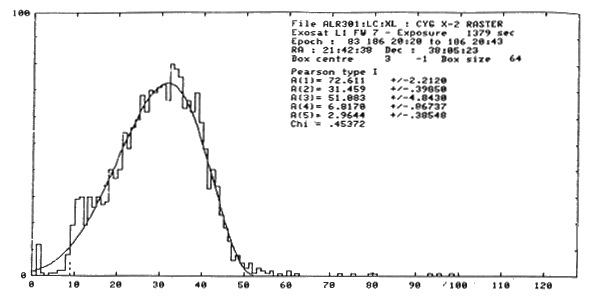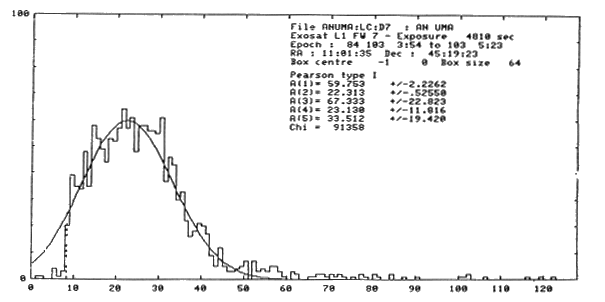[EXOSAT Home]
[About EXOSAT]
[Archive]
[Software]
[Gallery]
[Publications]
THE EXOSAT SUM SIGNAL EFFICIENCY CORRECTION :
DIRECT COMPUTATION FROM THE DATA
Readers not familiar with the CMA sum signal and its usage to compute
the sum signal-dependent efficiency correction are referred to the FOT
Handbook, section 8.1.3 for an introduction. The basic facts are summarised
below, then a new method (not described in the FOT Handbook) to compute
the efficiency correction directly from the data, without the use of the
CCF, is presented.
The sum signal is the summed output from the readout contacts on the
CMA resistive disc. It appears as an ADC channel number (0-127) for each
event in the IM packet. Since only events with a signal above a given threshold
(PET=Position Encoding Threshold) on any of the four contacts are considered
valid, a sum signal histogram (counts vs ADC channel no.) will start abruptly
at a given ADC channel, which is a function of the PET setting (so far
con- stant) and of the position in the field of view.
Events in channel O and 1 are spurious and should be disregarded. Since
the CMA efficiency given in the CCF was calculated using no PET, a correction
is necessary for a sum signal-dependent factor. This is simply the ratio
between the area of the sum signal distribution above the threshold, and
the total area (with no threshold). This method was used to generate the
correction factors in the CCF from the ground measurements (monochromatic
X-rays).
Data analysis at the EXOSAT Observatory has shown that the values in
the CCF are only guidelines to the in-flight behaviour (cosmic sources
are not monochromatic!). In particular, for a given sum signal distribution
and its median, the correction factor obtained from the CCF is underestimated
in comparison to the directly computed value.This implies that a larger
correction is necessary, i.e. the actual correction coefficient (which
is a number between O and 1) is lower (further from 1) than the predicted
value.
The difference is small for most of the normal X-ray distributions
(for which the correction factor is in any case close to 1), but could
be non-negligible for softer distributions (lower sum signal median).
The following method may be used to compute the efficiency correction
directly from the data. It assumes that a Pearson type I distribution describes
the source sum signal distribution; this is confirmed in practice. Naturally,
the parameters of the Pearson distribution are different from those for
a monochromatic distribution. No attempt has been made to model the sum
signal distribution from a continuum as a convolution of monochromatic
distributions: the Pearson fit provides a good empirical description.
- Accumulate a signal histogram y=f(x) using a set of values
yi for each channel i=0,127. The associated sum
signal value may be derived as xi=i-0.5.
- Locate the threshold to define the first channel to be fitted. This
can be done very easily by eye, or an automatic algorithm may be developed.
- Fit the data with the modified Pearson type I distribution
y = K ( 1 + (x - x0) / a1 )m1 . (1 - (x - x0) / a2)m2
where the five parameters K, x0, a1, m1,
m2 are variable and the following relation holds m1/a1
= m2/a2. A least squares fit method (e.g. Bevington's
CURFIT) can be used.
- The following assumptions are valid as initial parameter values:
K = height of the-peak of the distribution
xO= channel of the peak of the distribution
a1= xO
m1=ratio between the first channel (from the top)
with at least 10% of the peak counts, and xO
m2= m1
The above guesses generally lead to a quick convergence. In a few specific
cases the values require some adjustment (generally try to raise m1
and m2, i.e. make the distribution narrower). To select the
initial parameters by eye, please note:
K controls the peak height,
x0 and a1 control the peak position,
m1 and m2 control the skewness of the left and right wing of the distribution.
- Once the above parameters are calculated, the threshold for integration
should be determined.
One possible method is to calculate the channel numbers corresponding
to 80% and 20% of the histogram value at the threshold used for the fit
(point 2 above). The values may be determined in fractional channel numbers
using the y values for two adjacent channels (one above and one below 80%
or 20%), the x values defined according to the convention at point 1 above,
with a linear extrapolation. Further linear extrapolation can be used to
derive a fractional channel number (corresponding to 50% of the initial
y value at the threshold), which is the integration threshold.
- Integrals of the fit on all the channels and on that part above the
threshold determined at point 5 are computed. A straightforward numeric
integration (histogram summation) is sufficient.
- The efficiency correction is the ratio of the two integrations.
The above is used by the program EFCOR in the EXOSAT Observatory LE
Interactive Analysis System.
L. CHIAPPETTI


The top frame shows a sum signal histogram (and its Pearson fit) for a
hard X-ray source (Cyg X-2). The integration threshold is at
channel 9.0, and the efficency correction 97.4% ( compared with a CCF
value of 98.8% obtained from the sum signal median value of
30.5).
The bottom frame refers to a softer source (AN UMa). The integration
threshold is at channel 8.4 and the efficency correction is
92.7% ( to be compared with a prediction of 97.4% using the sum
signal median of 25.0).
[EXOSAT Home]
[About EXOSAT]
[Archive]
[Software]
[Gallery]
[Publications]
|